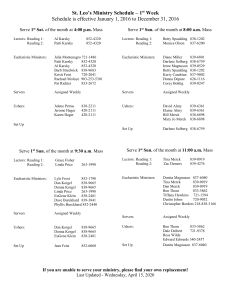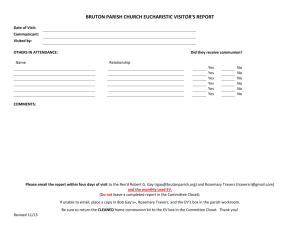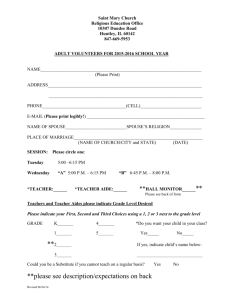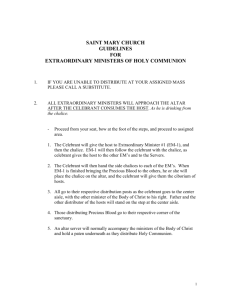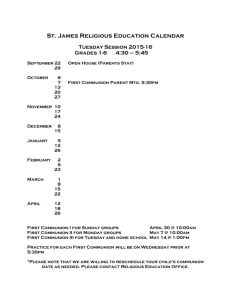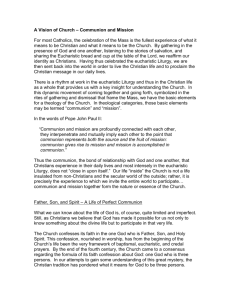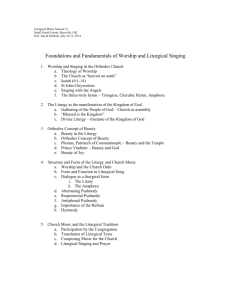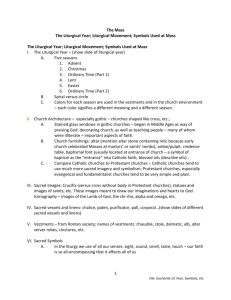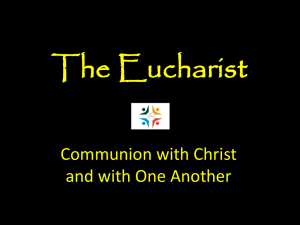Protocol for Coordinating Mass
advertisement
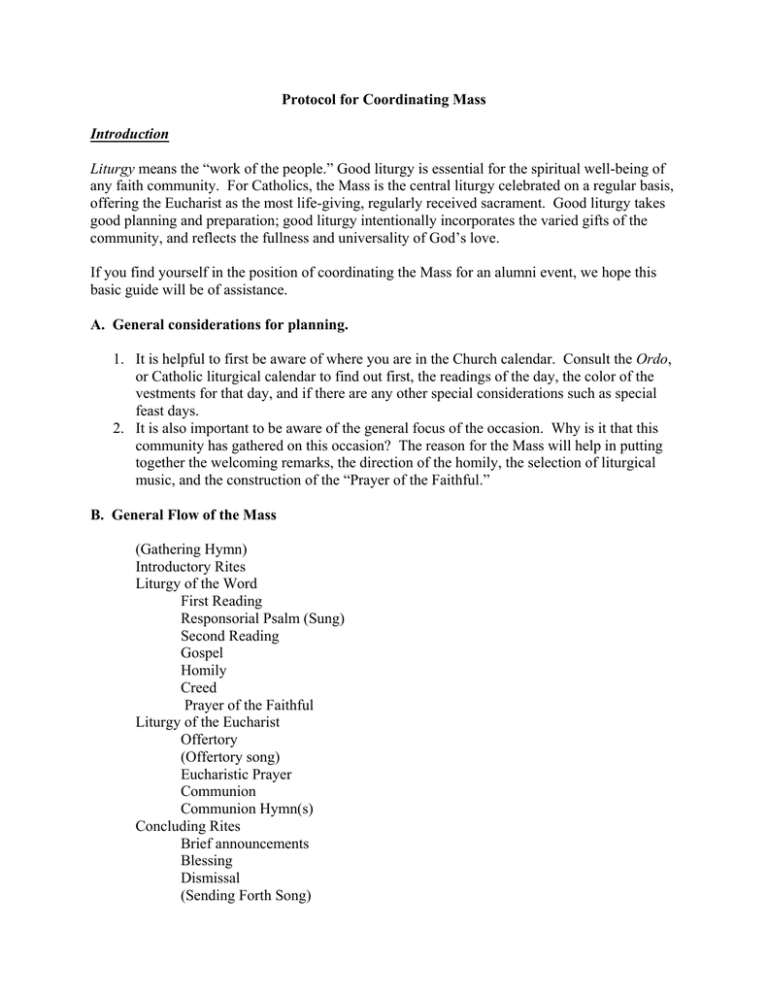
Protocol for Coordinating Mass Introduction Liturgy means the “work of the people.” Good liturgy is essential for the spiritual well-being of any faith community. For Catholics, the Mass is the central liturgy celebrated on a regular basis, offering the Eucharist as the most life-giving, regularly received sacrament. Good liturgy takes good planning and preparation; good liturgy intentionally incorporates the varied gifts of the community, and reflects the fullness and universality of God’s love. If you find yourself in the position of coordinating the Mass for an alumni event, we hope this basic guide will be of assistance. A. General considerations for planning. 1. It is helpful to first be aware of where you are in the Church calendar. Consult the Ordo, or Catholic liturgical calendar to find out first, the readings of the day, the color of the vestments for that day, and if there are any other special considerations such as special feast days. 2. It is also important to be aware of the general focus of the occasion. Why is it that this community has gathered on this occasion? The reason for the Mass will help in putting together the welcoming remarks, the direction of the homily, the selection of liturgical music, and the construction of the “Prayer of the Faithful.” B. General Flow of the Mass (Gathering Hymn) Introductory Rites Liturgy of the Word First Reading Responsorial Psalm (Sung) Second Reading Gospel Homily Creed Prayer of the Faithful Liturgy of the Eucharist Offertory (Offertory song) Eucharistic Prayer Communion Communion Hymn(s) Concluding Rites Brief announcements Blessing Dismissal (Sending Forth Song) C. Basic Elements needed for Mass: Sacramentary Book of the Gospels Candles Purificators Chalice(s), cups Water Communion wafers Lectionary (book of the readings) Altar Cloth Corporal Cruets for water and wine Patent, plates, dish, or ciborium for the hosts Wine D. Roles 1. Sacristan/ Liturgical coordinator The sacristan/ liturgical coordinator is a person who will organize the preparations for the Mass and who can make available all the liturgical supplies needed for Mass. This person, who doesn’t need to be a priest, is usually connected with the hosting church or at least comfortable in finding the needed items in the sacristy of the church. If Mass is celebrated in a separate room of hall, the sacristan would be responsible for procuring the needed elements from a church sacristy, with permission, and setting up all the elements, as well as coordinating all the roles of the participants. Best liturgical practices dictate that all participants will arrive at least one half hour before Mass for instruction and rehearsal if needed. 2. Master of Ceremonies The Master of Ceremonies, or M.C., is most often a priest, vested, and participating in the Mass. The role of the MC is to help to move participants into place during the Mass, and to help with the general flow of action. Note: MCs are really only needed in large, extra-ordinary liturgies, such as a University-wide mass, or the Baccalaureate Mass. 3. Greeter A member of the community with specific connections to the occasion generally serves as the Greeter. She or he may offer a 1-2 minute welcome before the start of Mass, pointing out certain special guests or VIPs. For example, it is the custom of the president of the BCAA national Board of Directors, if present, or another Board Member to offer the greeting before Laetare Sunday Mass in Boston. 4. Lectors Generally speaking, a Sunday Mass will require three Lectors, or readers for the first reading, the second reading, and the “Prayer of the Faithful.” Best liturgical practices will insist on a good gender balance among the lectors. The lectors should have their readings far enough in advance as to be able to practice sufficiently and become prayerfully familiar with them. Remind them to read slowly and deliberately, annunciating each word. Lectoring is not simply “reading”, it is proclaiming the Word of God! The lectors always bow to the altar when their paths cross in front of the altar; bow on the way up to the lectern, and bow on the way back to your seat. 5. Eucharistic Ministers Eucharistic Ministers, also known as, extraordinary ministers of communion, aid in the distribution of Holy Communion. The size of the congregation as well as the logistics of the space may dictate the number of Eucharistic Ministers needed. Generally speaking, the celebrant of the Mass and a concelebrant or two if present, will most likely offer communion. It is important to have lay members of the community, Eucharistic Ministers, serve communion along with them. Best liturgical practice is to have Holy Communion offered under both species, that is, the body of Christ, hosts, and the precious blood, cup. For example, in a Mass of approximately 100 people, you may want to have 4 Eucharistic Ministers: two for the distribution of the body of Christ, and 2 for the distribution of the cup of precious blood of Christ. More EMs are added for the size and needs of the community. Those serving as Eucharistic ministers come forward into the area around the altar during the “Lamb of God, and will be instructed by the sacristan, MC, or the celebrant. The Communion stations will have been shown to the Eucharistic Ministers well before the Mass has started. During Communion, the minister says, “The Body of Christ” or “The Blood of Christ,” clearly and with reverence when offering communion to the faithful. The basic criterion for someone to serve as a Eucharistic Minister is that they need not be perfect, but simply a be Mass-attending confirmed Catholic who can serve with faith and reverence. One needs not to have served previously or have been “commissioned” in the past, one is “commissioned” to serve that community at the time by virtue of the fact of being invited to serve. Best liturgical practices: it is not desirable to have people serve as Lectors and Eucharistic Ministers unless absolutely necessary; it is best to understand the two roles as separate and distinct. 6. Gift Bearers The Gift Bearers bring up from the community the bread or wafers and the wine which will be transformed through the mystery of transubstantiation, into the real body and blood of Christ. Depending on the layout of the vessels, 2, 3, or 4 persons may be involved. They move toward the gift table together after the close of the Prayer of the Faithful. The gifts may be brought up reverently when the priest and altar servers have moved in front of the altar and await them there. After handing off the gifts, it is customary for the gift bearers to bow before the altar. 7. Presider, Celebrant, Homilist or Preacher, and Concelebrants. The presider is literally the one who presides, or sometimes called the main celebrant. The presider may or may not be the homilist, the one who offers the homily, literally, the one who “breaks open the Word of God.” The concelebrants are other priests who process in and with the main celebrant, celebrate the Mass. 8. Ushers The ushers may serve two roles: first in welcoming the congregation with a warm smile and a kind word, while handing out the worship aid or programs. In addition, they may serve as the individuals who “handle the collection” during the Offertory. In some instances, simple baskets may be passed throughout the congregation, which the ushers may oversee and direct. On other occasions, they may use the more traditional stick handled baskets and proceed throughout the congregation front to back. The number of ushers may vary depending on he size of the community. E. Other Considerations 1. Worship Aids The BCAA will work with your chapter leaders in the consultation and creation of the program for Mass or Worship Aid. A sample program has been included. 2. Liturgical Music It is always best to have music at a Sunday Mass. We suggest that you contact or ask to be directed to a local (location of the Mass), and recommended, liturgical music coordinator for the handling of the music for the Mass. In addition to providing quality music for the Mass, she or he will help with navigating copyright laws to provide music in the worship aid or program. 3. The Procession The general order of the procession, which begins after the gathering hymn starts is: First: the cross-bearer Second: lectors, followed by a lector who carries the Book of the Gospels Third: the concelebrants Fourth: the Homilist, if different from the main celebrant. (If there is a Homilist, then the Homilies carries the Book of the Gospels.) Last: the main celebrant. All process in together slowly and reverently; upon nearing the sanctuary, fan out laterally and all bow together toward the altar, except the person holding the cross and the Book of the Gospels. The participants take their places and the Book of the Gospels is placed standing up in the Altar. The order is reversed during the recessional. 4. The Prayer of the Faithful It is customary to either use already prescribed prayers that one may acquire from an (arch) diocesan publication or liturgical magazine, or to simply and prayerfully write them one’s self. Generally speaking there are 6 basic prayers: 1) for the church universal/ connected with the theme of the Mass 2) for religious leaders 3) for secular leaders 4) for the poor 5) for justice and peace 6) for the dead Note: the lector who reads the Prayer of the Faithful walks to the lectern upon the conclusion of the Creed, then begins after the introduction by the celebrant, and remains at the lectern until the celebrant has closed the prayer. F. Let the Planning Begin The Planning Worksheet Greeting/Welcome: Cross bearer: Lector for First Reading Reading: Lector for Second Reading: Reading: Reading the General Intercessions (Prayer of the Faithful): Written by: Giftbearers: Eucharistic Ministers: Communion under both Species? 1) 6) 2) 7) 3) 8) 4) 9) 5) 10) Ushers: 1) 2) 3) 4) 5) 6) 7) 8) 9) 10)

